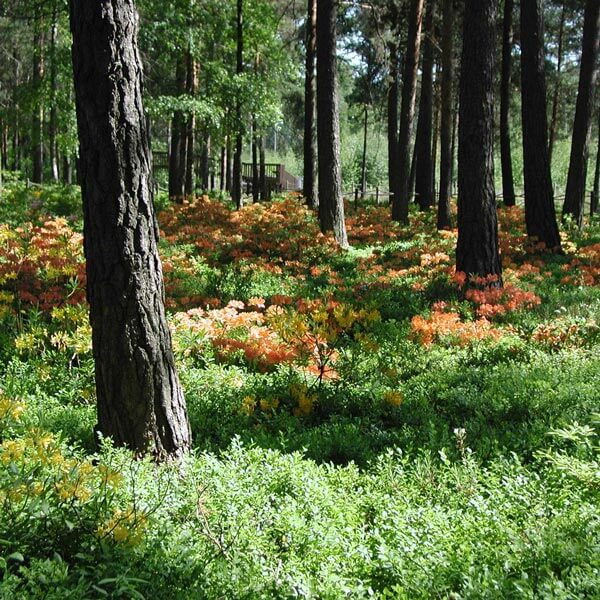The peak blooming season for both the rhododendrons and the azaleas is early June. The azaleas bloom first and sometimes longer than the rhododendrons, even after midsummer. The splendour of the flowers varies with each year; generally a good year is followed by a more modest one.
Pine trees create a canopy for the flowering plants. Thousands of Helsinki residents and gardening enthusiasts visit the park each year to witness the spectacle.
Rhododendron section
The oldest rhododendrons were planted in 1975, when a research garden for the University of Helsinki’s plant breeding programme was established together with the Public Works Department. Pekka Jyränkö, City Gardener from 1975 to 1995, was among the main drivers behind the project. Rhododendrons prefer acidic soil and so were planted in a natural marsh area. Paths were also constructed. The University of Helsinki and the City of Helsinki originally planted 3000 rhododendron hybrids for research purposes. The aim of the plant breeding programme was to create varieties that were suitable for the Finnish climate and diverse in terms of their growth and the colours of their flowers.
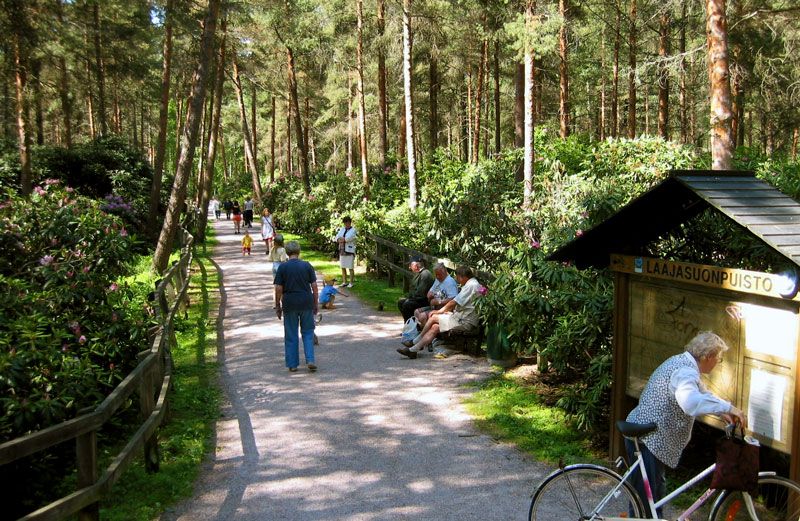
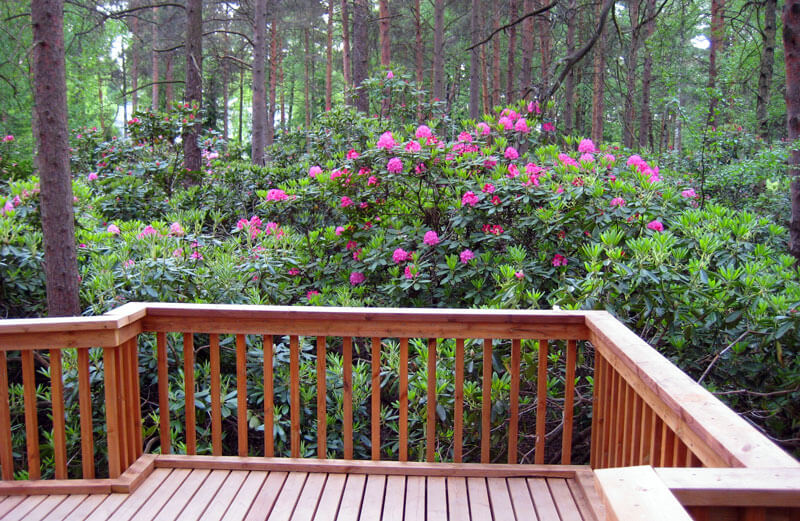
Rhodendron Park is the only park in Helsinki that has special viewing platforms for admiring the exotic flowers. The viewing platform in the rhododendron section is shaped like a bridge, allowing visitors to admire fully the flowers of the tall plants. There are also boardwalks through the park that are fully accessible by wheelchair. The park’s structures and signposting were renewed in 2009. All the signs are now in Finnish, Swedish and English.
Following long-term observation, over a dozen rhododendron varieties that grow in Finland have been selected for commercial production. Rhododendron Park supplied eight of these: ‘Haaga’, ‘Helsinki University’, ‘St. Michel’, ‘P.M.A. Tigerstedt’, ‘Axel Tigerstedt’, ‘Pekka’, ‘Eino’ and ‘Mauritz’. The original plants continue to grow in the park. The observation of older rhododendrons has now concluded, and the research area now serves as a public park.
Local rhododendron varieties
‘Haaga’ was named after the district in which Rhododendron Park can be found. This variety grows to a height of 1.5 to 2 metres and is roughly circular. In the centre of the pink flowers are darker spots that give them a stronger red appearance.
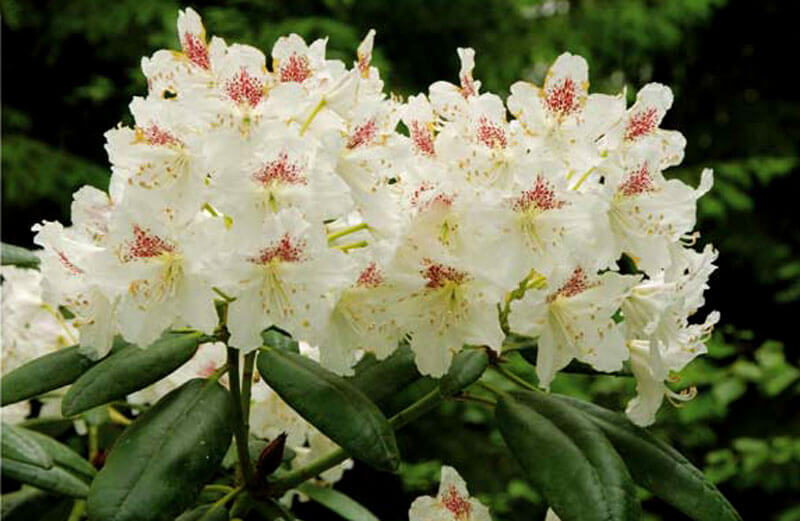
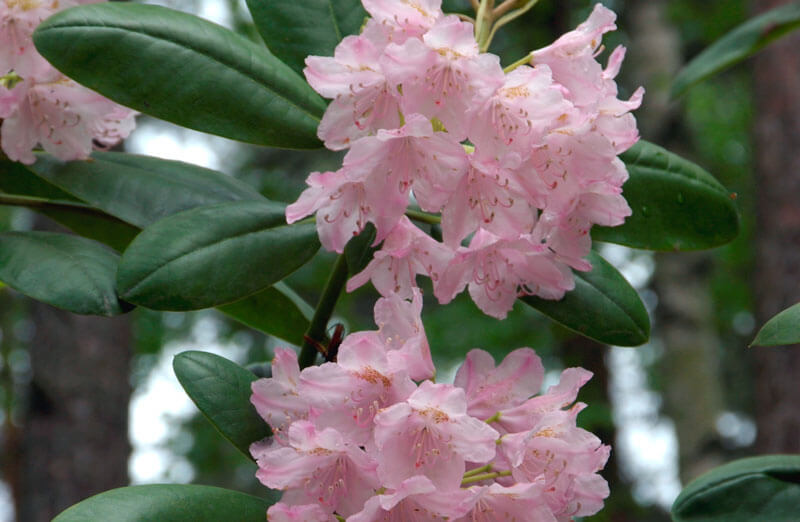
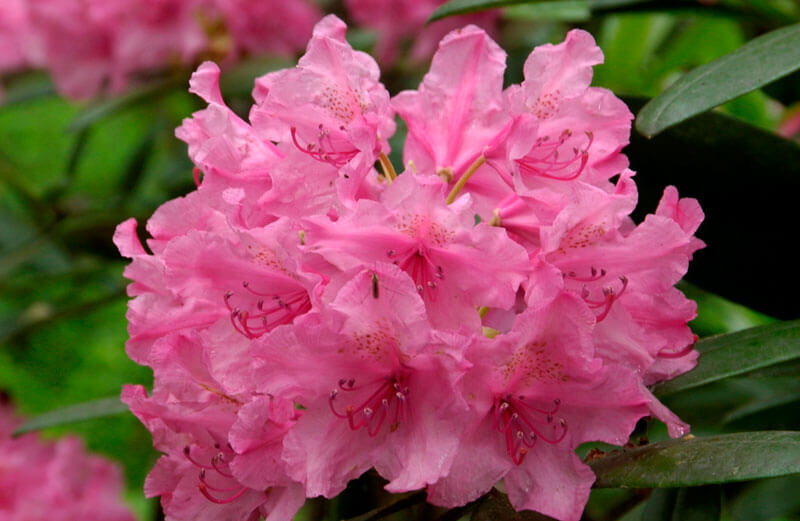
‘Pekka’ was named after Pekka Jyränkö, City Gardener from 1975 to 1995. This variety grows almost like a tree in broad bushes that are ideal for public areas and large gardens.
‘P.M.A. Tigerstedt’ was named after Peter Tigerstedt, Professor Emeritus at the University of Helsinki and founder of the rhododendron breeding programme. This variety grows to a height of over two metres and generally produces many flowers. The white flowers have reddish brown spots in the centre.
Azalea section
In spring 1996 Rhododendron Park was extended to the north of the cycle path. Thousands of new yellow rhododendrons and many park azaleas were planted in the new section. The azaleas were the result of an azalea breeding programme that began in 1986.
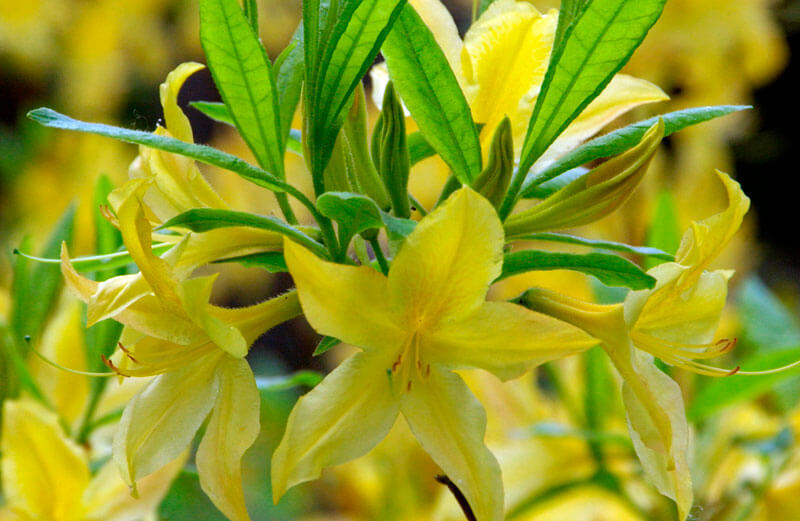
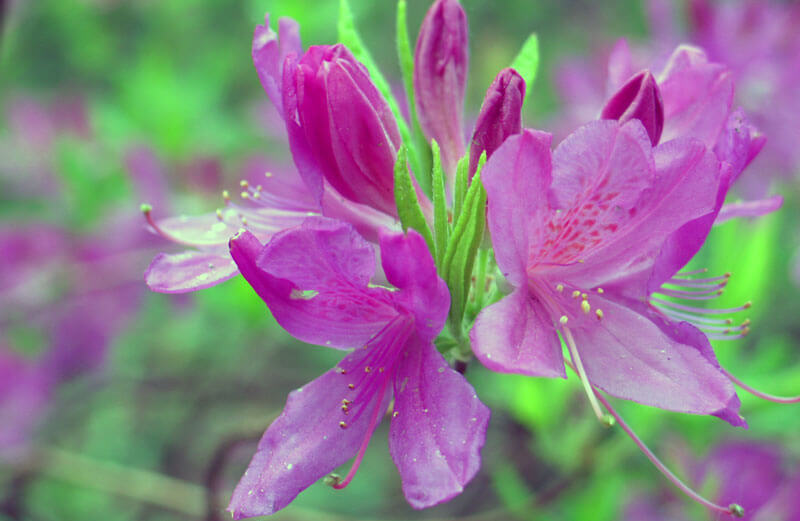
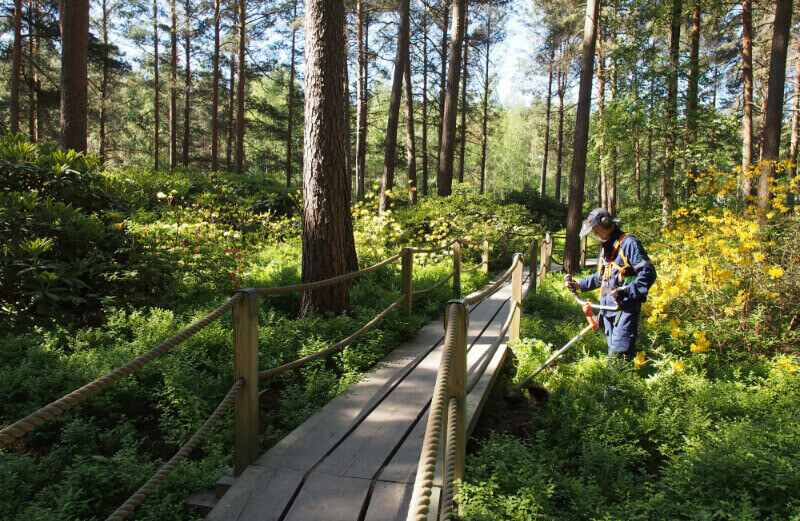
These plants are also part of a larger crossbreeding selection. Altogether around 1500 park azaleas grow in the azalea section. The yellow rhododendrons bloom early, often in the first days of June at the same time as the first yellow azaleas begin to flower.
Unlike evergreen rhododendrons, park azaleas drop their leaves for the winter. The shrubs are also smaller and more delicate than other rhododendrons. The flowers are yellow, red-orange, pink and white. Park azaleas are also less demanding than other rhododendrons regarding where they are planted, although they do need more sun to flower than other rhododendrons.
The aim of the azalea breeding programme has been to breed varieties that can withstand the cold winters. The plants are also observed to study how they grow, their size, their flowers and their autumn colouring. The first domestic park azalea varieties were introduced to the market in 2010.
Yellow is a particularly popular colour for rhododendrons, but so far winter hardy varieties have been lacking. The yellow rhododendrons bloom in early June with large pale yellow and greenish yellow flowers.
In 2010 a new woodland garden was added to the azalea section of Rhododendron Park. Various hortensia shrubs (Hortensia spp.), azaleas and other flowering shade shrubs that were selected for the new section.
Finland is home to two native varieties of rhododendron. Rhododendron lapponicum is very rare and found in the fells of Lapland, while Rhododendron tomentosum thrives in bogs and marshes and has branches that emit a strong scent. Rhododendron tomentosum grows naturally along the edges of Rhododendron Park and attracts especially foreign rhododendron enthusiasts. This variety also thrives as a garden plant, and it was once used in homes to keep away bugs and keep the linen fresh smelling. It was also said that when worn around the neck it helped keep churchgoers awake during the service.
How do azaleas differ from rhododendrons?
When Finns talk about rhododendrons, they are usually referring to evergreen park rhododendrons with blue-violet flowers (Rhododendron catawbiense) or one of its varieties with red or white flowers. Few remember that the name rhododendron refers to an entire genus of almost 900 species, which include deciduous azaleas. In addition, almost 5000 shrub-like rhododendron breeds have been registered.
Rhododendrons flourish in the eastern parts of the Himalayan mountains, as well as in the mountains of Indochina, Korea, Japan and Taiwan. Several varieties are also native to North America and Europe. Some tropical varieties grow as far south as Borneo and New Guinea, but they do not grow in Africa or South America.
Since the majority of rhododendron varieties are native to mountainous regions that receive heavy rainfall, they require large quantities of water to flourish. Rhododendrons thrive in acidic, organic and spongy soil. The fine roots are very close to the surface and cover a small area, so they are easily damaged.
Rhododendrons are mycorrhiza plants, meaning that they have fungal roots. The symbiotic fungus accounts largely for the plant’s nutrition, especially phosphorous. Mycorrhiza plants are very resilient to droughts and diseases. They require very little fertiliser. If chemical fertiliser is used that is too strong, it can impair the fungus and be harmful to the plant over the long term. Only chlorine-free fertilisers should be used on rhododendrons.
The roots are protected from drying and from the heat by the forest undergrowth. However, the undergrowth must not be too strong or have too many roots so as not to compete with the roots of the rhododendrons.
Rhododendrons generally require tree cover to protect the leaves from excessive sunlight and wind. The trees providing the cover should have deep roots so that they do not compete with the rhododendrons. Too much shade should also be avoided. The ideal solution is to have shade the moves throughout the day.
Rhododendron branches are fragile and break easily. However, they cope well with trimming. The branches have dormant buds that can begin to grow when cut. They may also form new shoots at their base.
Rhododendrons can produce seedlings. The flowers on the seedlings in Rhododendron Park can be any colour. The method of growing them also varies. Seedlings under 0.5 metres in height can be transferred with their root system during the off season. The flowering branches then form during the late summer and early autumn.
Azaleas (Rhododendron japonicum) prefer the sun more than evergreen rhododendrons. They also produce better colours and flowers in sunny places.
Signposting
-
1 Rhododendron Park, testing ground for plant breeding
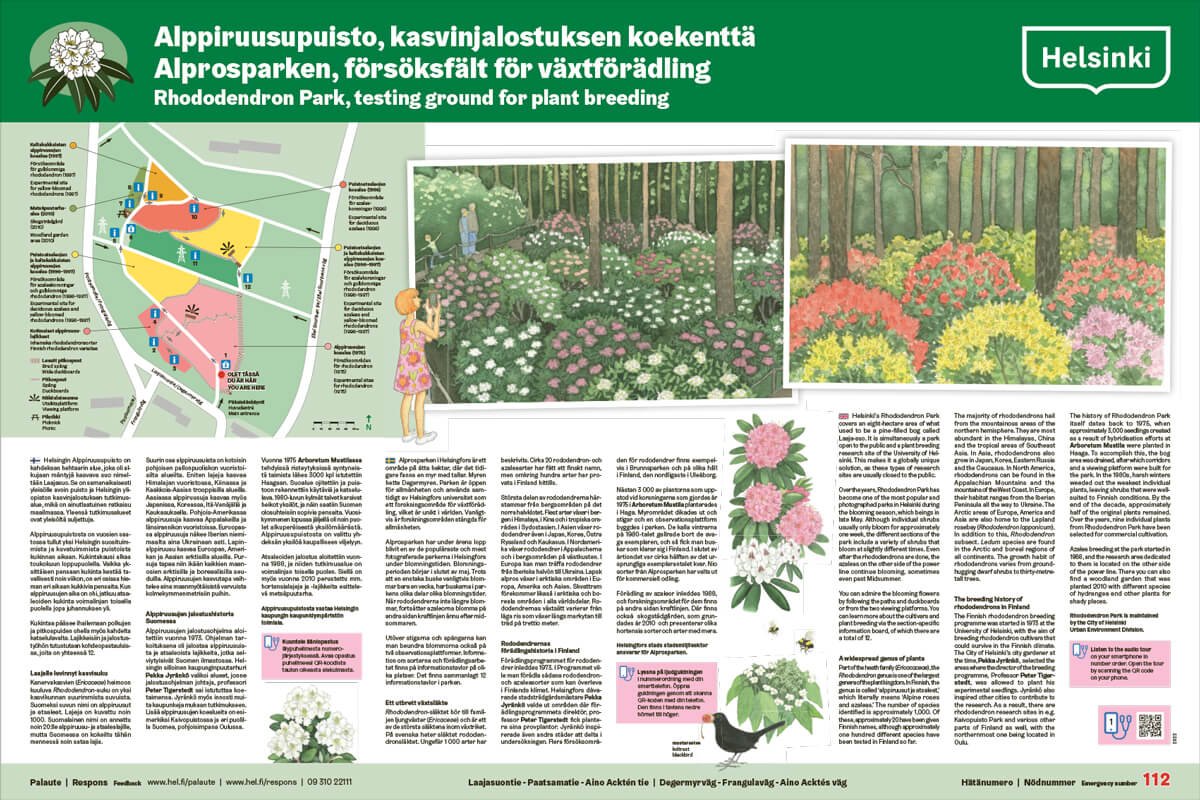
Helsinki’s Rhododendron Park covers an eight-hectare area of what used to be a pine-filled bog called Laajasuo. It is simultaneously a park open to the public and a plant breeding research site of the University of Helsinki. This makes it a globally unique solution, as these types of research sites are usually closed to the public.
Over the years, Rhododendron Park has become one of the most popular and photographed parks in Helsinki during the blooming season, which beings in late May. Although individual shrubs usually only bloom for approximately one week, the different sections of the park include a variety of shrubs that bloom at slightly different times. Even after the rhododendrons are done, the azaleas on the other side of the power line continue blooming, sometimes even past Midsummer.
You can admire the blooming flowers by following the paths and duckboards or from the two viewing platforms. You can learn more about the cultivars and plant breeding via the section-specific information board, of which there are a total of 12.
A widespread genus of plants
Part of the heath family (Ericacaceae), the Rhododendron genus is one of the largest genera of the plantkingdom. In Finnish, the genus is called ‘alppiruusut ja atsaleat,’ which literally means ‘Alpine roses and azaleas.’ The number of species identified is approximately 1,000. Of these, approximately 20 have been given Finnish names, although approximately one hundred different species have been tested in Finland so far.
The majority of rhododendrons hail from the mountainous areas of the northern hemisphere. They are most abundant in the Himalayas, China and the tropical areas of Southeast Asia. In Asia, rhododendrons also grow in Japan, Korea, Eastern Russia and the Caucasus. In North America, rhododendrons can be found in the Appalachian Mountains and the mountains of the West Coast. In Europe, their habitat ranges from the Iberian Peninsula all the way to Ukraine. The Arctic areas of Europe, America and Asia are also home to the Lapland rosebay (Rhododendron lapponicum). In addition to this, Rhododendron subsect. Ledum species are found in the Arctic and boreal regions of all continents. The growth habit of rhododendrons varies from ground-hugging dwarf shrubs to thirty-metre-tall trees.
The breeding history of rhododendrons in Finland
The Finnish rhododendron breeding programme was started in 1973 at the University of Helsinki, with the aim of breeding rhododendron cultivars that could survive in the Finnish climate. The City of Helsinki’s city gardener at the time, Pekka Jyränkö, selected the areas where the director of the breeding programme, Professor Peter Tigerstedt, was allowed to plant his experimental seedlings. Jyränkö also inspired other cities to contribute to the research. As a result, there are rhododendron research sites in e.g. Kaivopuisto Park and various other parts of Finland as well, with the northernmost one being located in Oulu.
The history of Rhododendron Park itself dates back to 1975, when approximately 3,000 seedlings created as a result of hybridisation efforts at Arboretum Mustila were planted in Haaga. To accomplish this, the bog area was drained, after which corridors and a viewing platform were built for the park. In the 1980s, harsh winters weeded out the weakest individual plants, leaving shrubs that were wellsuited to Finnish conditions. By the end of the decade, approximately half of the original plants remained. Over the years, nine individual plants from Rhododendron Park have been selected for commercial cultivation.
Azalea breeding at the park started in 1988, and the research area dedicated to them is located on the other side of the power line. There you can also find a woodland garden that was planted 2010 with different species of hydrangea and other plants for shady places.
-
2 11 enduring beauties

This section was established in 2009 and features cultivars selected for commercial propagation from the University of Helsinki’s breeding programme. The plants were bred by Marjatta Uosukainen, and these cultivars are often collectively referred to as ‘marjatanalppiruusut,’ meaning ‘Marjatta’s rhododendrons.
‘Axel Tigerstedt’
This cultivar usually blooms in early June. The pink buds fade into white flowers, and during blooming the shrub displays both hues, like an apple tree. Downy on the underside, the leaves stay on the shrubs for a long time, making this an excellent garden shrub. This cultivar is sourced from the Haaga Rhododendron Park. It is named after Peter Tigerstedt’s brother.
‘Eino’
This cultivar is a broad shrub that does not grow very tall. The flower is purple, with a distinct lighter, flame-like pattern. It grows plenty of leaves and produces an abundance of flowers, making this a very impressive cultivar. This cultivar is sourced from the Haaga Rhododendron Park. It is named after the breeder’s father.
‘Elviira’
‘Elviira’ is the first cultivar produced by the breeding programme that was selected for commercial propagation and cultivation. Blooming in May with bright red flowers, the shrub usually remains under half a metre tall. Thrives in locations with fresh vegetation and sufficient shade. This cultivar is sourced from Elimäki. It is named after the breeder’s grandmother.
‘Kaino’ • ‘Vieno’ • ‘Venla’
These cultivars were grown from seeds imported from Germany instead of being creations of the breeding programme. Since the shrubs turned out to be beautiful, hardy and early bloomers, the trio were added to the series of Finnish rhododendrons. The main difference between the cultivars is the colour of the flowers. ‘Kaino’ has delicate pink flowers, ‘Vieno’ has yellow-red ones and ‘Venla’ has pink flowers with a dark throat. The shrubs are not named after anyone; the names were selected simply because they rhyme. ‘Kaino’ produces the least flowers of the three, as the name would suggest (kaino is Finnish for bashful).
‘Kullervo’
‘Kullervo’ is a densely growing cultivar with very downy leaves that produces pink buds that open into white flowers. The shrub is an impressive sight outside of the blooming season as well. This cultivar is sourced from the Kaivopuisto research site. It is named after a character in the Kalevala, the national epic of Finland.
‘Marketta’
Smirnow rhododendron hybrid ‘Marketta’ is a reliable bloomer. Its two-tone flowers are reddish at the edges, with light throats. The corolla has dark spots. As a shrub, it is medium-sized and very winterhardy. The undersides of the leaves are covered in down. This cultivar is sourced from Arboretum Mustila. It is named after the breeder’s sister.
‘Mauritz’
The red-flowered ‘Mauritz’ adds a splash of colour to spring. Its growth habit is short, and having small leaves it can appear to be rather sparse, especially in shadier locations. This cultivar is sourced from the Haaga Rhododendron Park. It is named after the breeder’s spouse.
‘Pohjolan Tytär’
‘Pohjolan Tytär’ is a great decorative shrub for north-facing walls or places where it is protected from the late winter and early spring sun. The shrub is wider than it is tall, and blooms slightly earlier than most other varieties. The pink buds open into white flowers. This cultivar is sourced from the Mikkeli research site. It is named after a character in the Kalevala, the national epic of Finland.
‘Raisa’
Growing only one metre tall, the vividly pink flowers of this shrub bloom quite late in June. This cultivar is sourced from Arboretum Mustila. The short ‘Raisa’ is named after Raisa Gorbacheva, the wife of the last President of the Soviet Union, Mikhail Gorbachev.
-
3 The fascinating world of plant breeding

This section features cultivars from the University of Helsinki’s breeding programme and other Finnish breeders. It was established in 2022.
The section also includes planted conifers, namely mountain hemlock (Tsuga mertensiana) and western hemlock (Tsuga heterophylla). Native to North America, these trees are relatives of the Norway spruce. Their growth habit is pretty and delicate. The western hemlock is characterised by its beautiful drooping branches and top shoot.
Over time, hemlocks grow into large trees, yet they retain their delicate and gently drooping branches and needles. They are best-suited for shady sites where they have room to grow and the ground is rich in nutrients.
‘Alli’
This winter-hardy cultivar was a favourite of gardener and rhododendron enthusiast Reijo Hahkala, which is why it was added to the section. ‘Alli’ blooms in early May, producing white flowers with yellow-green spots. Its growth habit is pillow-like, and the dark, glossy leaves make it a very beautiful green shrub. It is named after Hahkala’s grandmother.
‘Jussi’
A robust cultivar with colourful flowers that withstands winter conditions well. The throats of its pink flowers have dark red spots, making it one of the most colourful Finnish rhododendrons. This cultivar is sourced from the Piikkiö research site. It is named after the name celebrated on Midsummer.
‘Kristiina’
The upright growth habit, large, dark green leaves and dense flowers make this cultivar a festive-looking shrub. The aniline red flowers are quite large. This cultivar is sourced from Helsinki’s Kaivopuisto. It is named after Lecturer Christine Tammisto, who lived in Mustila.
‘Suomi 100’
The first yellow-flowered Finnish rhododendron ‘Suomi 100’ commemorated the centenary of Finnish independence in 2017. This cultivar is sourced from Arboretum Mustila.
‘Suvi’
‘Suvi’ is a short Williams rhododendron hybrid that blooms early, producing pink flowers. Its annual growth is initially reddish, making the shrub stand out from other varieties. This cultivar is sourced from Helsinki’s Kaivopuisto. The naming history of ‘Suvi’ is unknown.
‘Terta’
‘Terta’ is a hybrid of the cultivars ‘Kullervo’ and ‘Elviira’ that is named after Tervetaimiasema, a since decommissioned plant hygiene station that was used in Finnish selected plant production. It produces delicate, pink flowers that quickly turn yellow-white. Its leaves are slightly curved.
‘Tiuku’
‘Tiuku’ is an old Williams rhododendron hybrid selected for cultivation from Arboretum Mustila. Most likely bred by German Dietrich Hobbie, it has proven very hardy. With its round leaves and bell-like flowers, it is an excellent addition to the range of hardy Finnish rhododendrons. The cultivar is named after the daughter of a former employee of Mustila.
‘Unelma’
Smirnow rhododendron hybrid ‘Unelma’ is one of the many cultivars selected for propagation from Haaga. It grows large and is usually wider than it is tall. The shoots and undersides of the leaves are covered in down. Its large, light aniline red flowers have dark spots. This cultivar is easier to grow than its dark-flowered sister, ‘Hellikki.’ It is not named after anyone in particular.
-
4 The first Finnish rhododendron cultivars
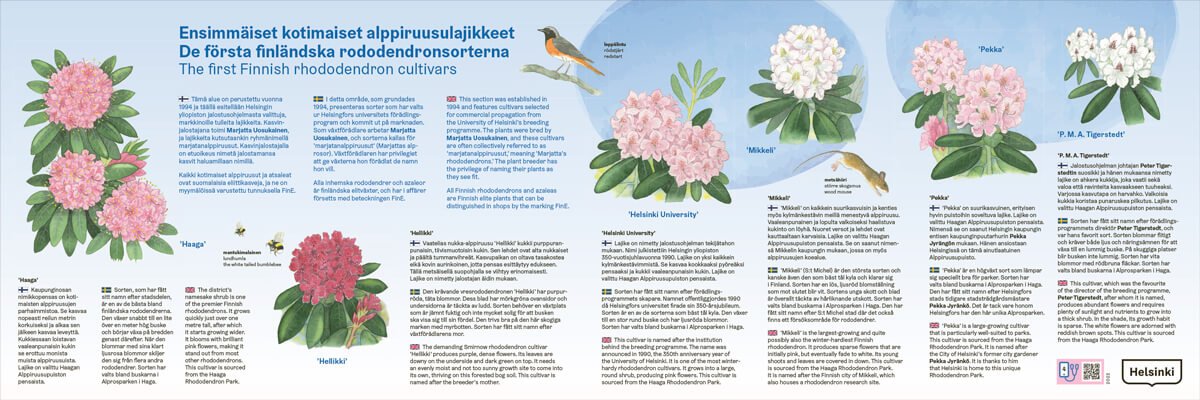
This section was established in 1994 and features cultivars selected for commercial propagation from the University of Helsinki’s breeding programme. The plants were bred by Marjatta Uosukainen, and these cultivars are often collectively referred to as ‘marjatanalppiruusut,’ meaning ‘Marjatta’s rhododendrons.’ The plant breeder has the privilege of naming their plants as they see fit.
All Finnish rhododendrons and azaleas are Finnish elite plants that can be distinguished in shops by the marking FinE.
‘Haaga’
The district’s namesake shrub is one of the premier Finnish rhododendrons. It grows quickly just over one metre tall, after which it starts growing wider. It blooms with brilliant pink flowers, making it stand out from most other rhododendrons. This cultivar is sourced from the Haaga Rhododendron Park.
‘Hellikki’
The demanding Smirnow rhododendron cultivar ‘Hellikki’ produces purple, dense flowers. Its leaves are downy on the underside and dark green on top. It needs an evenly moist and not too sunny growth site to come into its own, thriving on this forested bog soil. This cultivar is named after the breeder’s mother.
‘Helsinki University’
This cultivar is named after the institution behind the breeding programme. The name was announced in 1990, the 350th anniversary year of the University of Helsinki. It is one of the most winter-hardy rhododendron cultivars. It grows into a large, round shrub, producing pink flowers. This cultivar is sourced from the Haaga Rhododendron Park.
‘Mikkeli’
‘Mikkeli’ is the largest-growing and quite possibly also the winter-hardiest Finnish rhododendron. It produces sparse flowers that are initially pink, but eventually fade to white. Its young shoots and leaves are covered in down. This cultivar is sourced from the Haaga Rhododendron Park. It is named after the Finnish city of Mikkeli, which also houses a rhododendron research site.
‘Pekka’
‘Pekka’ is a large-growing cultivar that is particularly well-suited to parks. This cultivar is sourced from the Haaga Rhododendron Park. It is named after the City of Helsinki’s former city gardener Pekka Jyränkö. It is thanks to him that Helsinki is home to this unique Rhododendron Park.
‘P.M.A. Tigerstedt’
This cultivar, which was the favourite of the director of the breeding programme, Peter Tigerstedt, after whom it is named, produces abundant flowers and requires plenty of sunlight and nutrients to grow into a thick shrub. In the shade, its growth habit is sparse. The white flowers are adorned with reddish brown spots. This cultivar is sourced from the Haaga Rhododendron Park.
-
5 Naturally occurring Canada rosebay
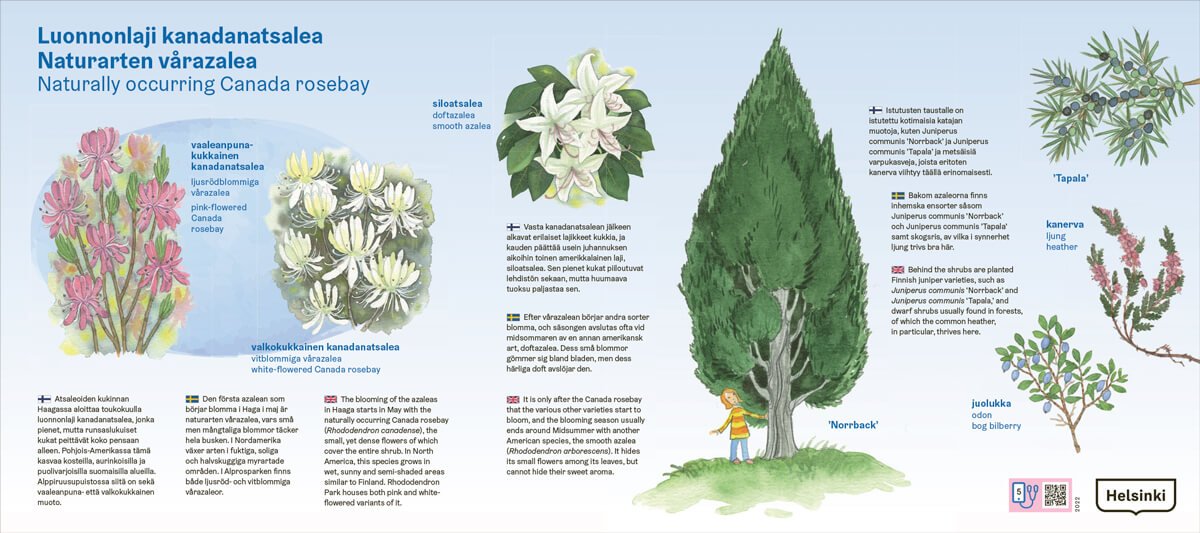
The blooming of the azaleas in Haaga starts in May with the naturally occurring Canada rosebay (Rhododendron canadense), the small, yet dense flowers of which cover the entire shrub. In North America, this species grows in wet, sunny and semi-shaded areas similar to Finland. Rhododendron Park houses both pink and white-flowered variants of it.
It is only after the Canada rosebay that the various other varieties start to bloom, and the blooming season usually ends around Midsummer with another American species, the smooth azalea (Rhododendron arborescens). It hides its small flowers among its leaves, but cannot hide their sweet aroma.
Behind the shrubs are planted Finnish juniper varieties, such as Juniperus communis ‘Norrback’ and Juniperus communis ‘Tapala,’ and dwarf shrubs usually found in forests, of which the common heather, in particular, thrives here.
-
6 Azaleas, fragrant bursts of colour in the spring and autumn
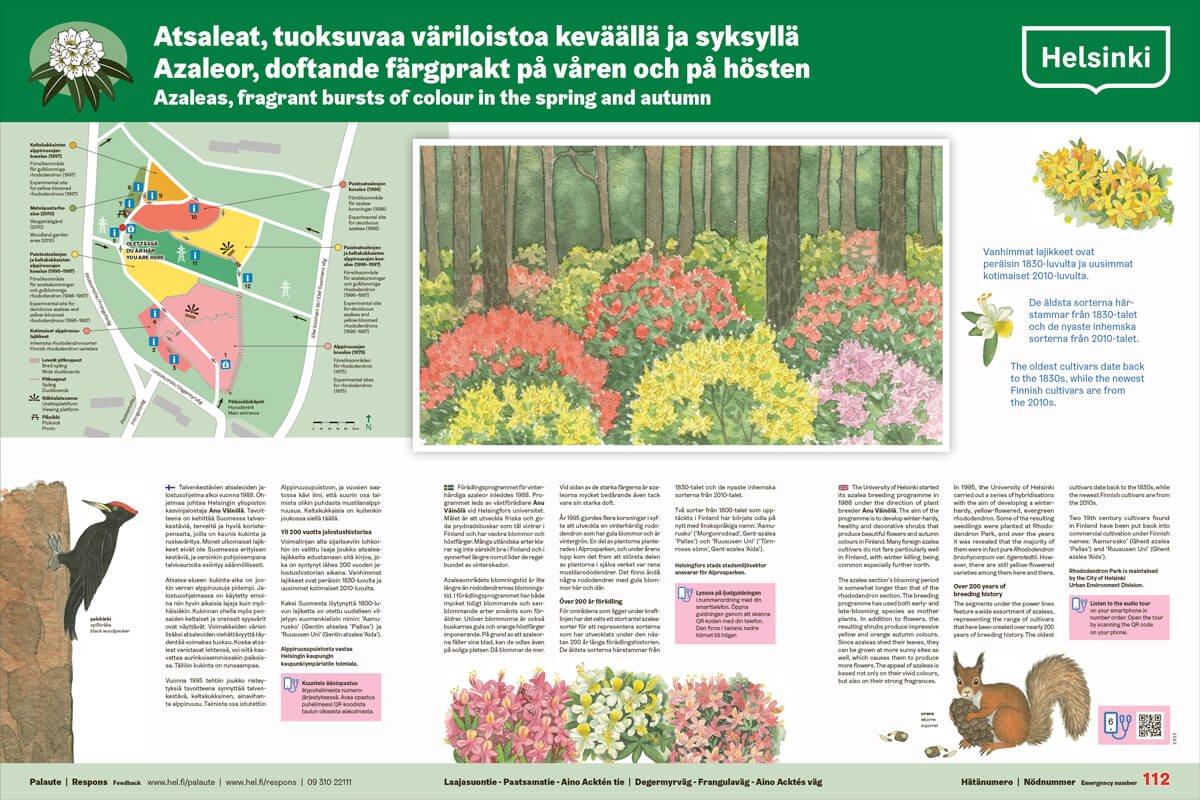
The University of Helsinki started its azalea breeding programme in 1988 under the direction of plant breeder Anu Väinölä. The aim of the programme is to develop winter-hardy, healthy and decorative shrubs that produce beautiful flowers and autumn colours in Finland. Many foreign azalea cultivars do not fare particularly well in Finland, with winter killing being common especially further north.
The azalea section’s blooming period is somewhat longer than that of the rhododendron section. The breeding programme has used both early- and late-blooming species as mother plants. In addition to flowers, the resulting shrubs produce impressive yellow and orange autumn colours. Since azaleas shed their leaves, they can be grown at more sunny sites as well, which causes them to produce more flowers. The appeal of azaleas is based not only on their vivid colours, but also on their strong fragrances.
In 1995, the University of Helsinki carried out a series of hybridisations with the aim of developing a winterhardy, yellow-flowered, evergreen rhododendron. Some of the resulting seedlings were planted at Rhododendron Park, and over the years it was revealed that the majority of them were in fact pure Rhododendron brachycarpum var. tigerstedtii. However, there are still yellow-flowered varieties among them here and there.
Over 200 years of breeding history
The segments under the power lines feature a wide assortment of azaleas, representing the range of cultivars that have been created over nearly 200 years of breeding history. The oldest cultivars date back to the 1830s, while the newest Finnish cultivars are from the 2010s.
Two 19th century cultivars found in Finland have been put back into commercial cultivation under Finnish names: ’Aamurusko’ (Ghent azalea ‘Pallas’) and ’Ruususen Uni’ (Ghent azalea ‘Aida’).
-
7 Woodland garden, beautified nature
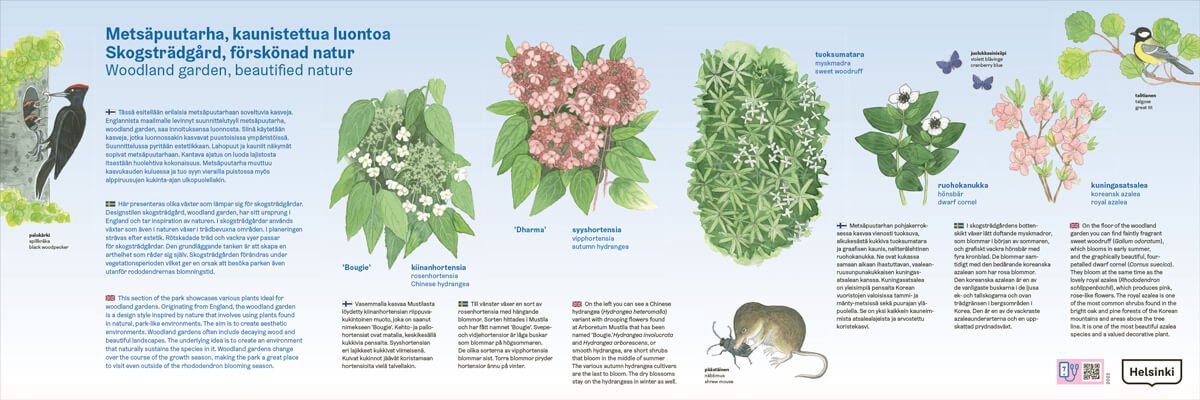
This section of the park showcases various plants ideal for woodland gardens. Originating from England, the woodland garden is a design style inspired by nature that involves using plants found in natural, park-like environments. The aim is to create aesthetic environments. Woodland gardens often include decaying wood and beautiful landscapes. The underlying idea is to create an environment that naturally sustains the species in it. Woodland gardens change over the course of the growth season, making the park a great place to visit even outside of the rhododendron blooming season.
On the left you can see a Chinese hydrangea (Hydrangea heteromalla) variant with drooping flowers found at Arboretum Mustila that has been named ’Bougie.’Hydrangea involucrata and Hydrangea arborescens, or smooth hydrangea, are short shrubs that bloom in the middle of summer. The various autumn hydrangea cultivars are the last to bloom. The dry blossoms stay on the hydrangeas in winter as well.
On the floor of the woodland garden you can find faintly fragrant sweet woodruff (Galium odoratum), which blooms in early summer, and the graphically beautiful, four-petalled dwarf cornel (Cornus suecica). They bloom at the same time as the lovely royal azalea (Rhododendron schlippenbachii), which produces pink, rose-like flowers. The royal azalea is one of the most common shrubs found in the bright oak and pine forests of the Korean mountains and areas above the tree line. It is one of the most beautiful azalea species and a valued decorative plant.
-
8 Diversifying parks through experiments
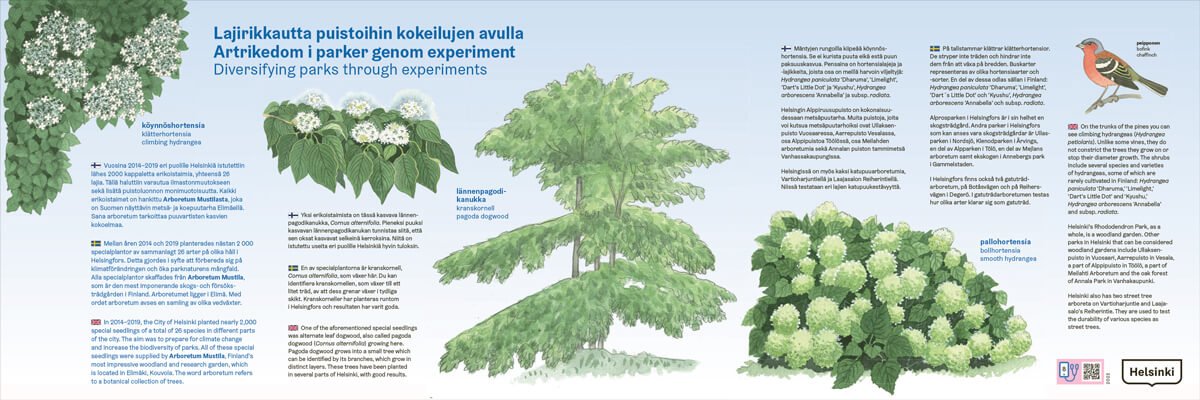
In 2014–2019, the City of Helsinki planted nearly 2,000 special seedlings of a total of 26 species in different parts of the city. The aim was to prepare for climate change and increase the biodiversity of parks. All of these special seedlings were supplied by Arboretum Mustila, Finland’s most impressive woodland and research garden, which is located in Elimäki, Kouvola. The word arboretum refers to a botanical collection of trees.
One of the aforementioned special seedlings was alternate leaf dogwood, also called pagoda dogwood (Cornus alternifolia) growing here. Pagoda dogwood grows into a small tree which can be identified by its branches, which grow in distinct layers. These trees have been planted in several parts of Helsinki, with good results.
On the trunks of the pines you can see climbing hydrangeas (Hydrangea petiolaris). Unlike some vines, they do not constrict the trees they grow on or stop their diameter growth. The shrubs include several species and varieties of hydrangeas, some of which are rarely cultivated in Finland: Hydrangea paniculata ‘Dharuma,’ ‘Limelight,’ ‘Dart’s Little Dot’ and ‘Kyushu,’ Hydrangea arborescens ‘Annabella’ and subsp. radiata.
Helsinki’s Rhododendron Park, as a whole, is a woodland garden. Other parks in Helsinki that can be considered woodland gardens include Ullaksenpuisto in Vuosaari, Aarrepuisto in Vesala, a part of Alppipuisto in Töölö, a part of Meilahti Arboretum and the oak forest of Annala Park in Vanhakaupunki.
Helsinki also has two street tree arboreta on Vartioharjuntie and Laajasalo’s Reiherintie. They are used to test the durability of various species as street trees.
-
9 Crossbreeding requires patience
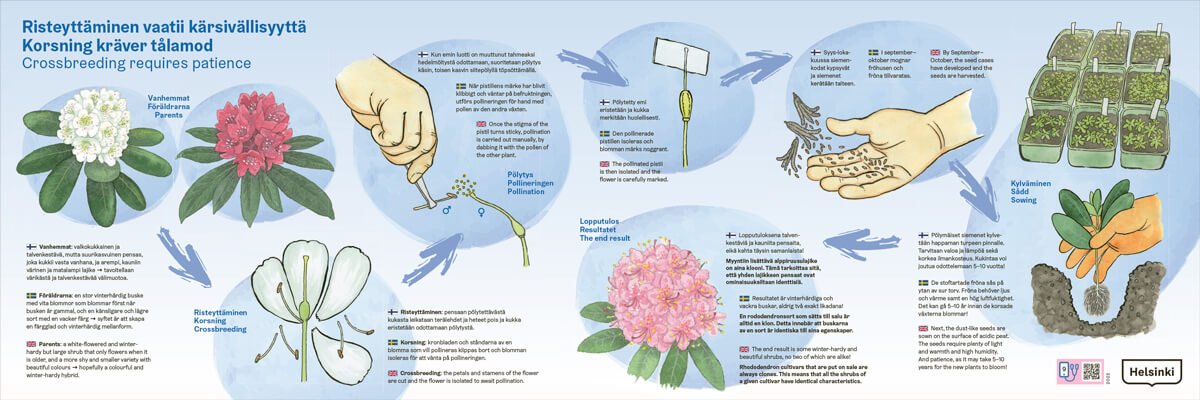
Parents
A white-flowered and winter-hardy but large shrub that only flowers when it is older, and a more shy and smaller variety with beautiful colours –> hopefully a colourful and winter-hardy hybrid.
Crossbreeding
The petals and stamens of the flower are cut and the flower is isolated to await pollination.
Pollination
Once the stigma of the pistil turns sticky, pollination is carried out manually, by dabbing it with the pollen of the other plant.
The pollinated pistil is then isolated and the flower is carefully marked.
By September–October, the seed cases have developed and the seeds are harvested.
Sowing
Next, the dust-like seeds are sown on the surface of acidic peat. The seeds require plenty of light and warmth and high humidity. And patience, as it may take 5–10 years for the new plants to bloom!
The end result
The end result is some winter-hardy and beautiful shrubs, no two of which are alike! Rhododendron cultivars that are put on sale are always clones. This means that all the shrubs of a given cultivar have identical characteristics
-
10 Azalea breeding in Finland
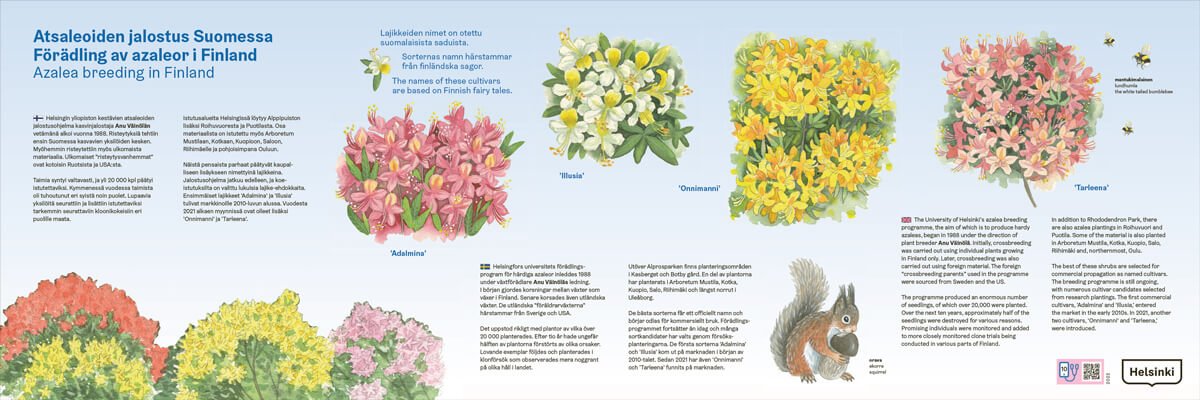
The University of Helsinki’s azalea breeding programme, the aim of which is to produce hardy azaleas, began in 1988 under the direction of plant breeder Anu Väinölä. Initially, crossbreeding was carried out using individual plants growing in Finland only. Later, crossbreeding was also carried out using foreign material. The foreign “crossbreeding parents” used in the programme were sourced from Sweden and the US.
The programme produced an enormous number of seedlings, of which over 20,000 were planted. Over the next ten years, approximately half of the seedlings were destroyed for various reasons. Promising individuals were monitored and added to more closely monitored clone trials being conducted in various parts of Finland.
In addition to Rhododendron Park, there are also azalea plantings in Roihuvuori and Puotila. Some of the material is also planted in Arboretum Mustila, Kotka, Kuopio, Salo, Riihimäki and, northernmost, Oulu.
The best of these shrubs are selected for commercial propagation as named cultivars. The breeding programme is still ongoing, with numerous cultivar candidates selected from research plantings. The first commercial cultivars, ‘Adalmina’ and ‘Illusia,’ entered the market in the early 2010s. In 2021, another two cultivars, ‘Onnimanni’ and ‘Tarleena,’ were introduced. The names of these cultivars are based on Finnish fairy tales.
-
11 Section of the Rhododendron Park in its natural state, part of Laajasuo
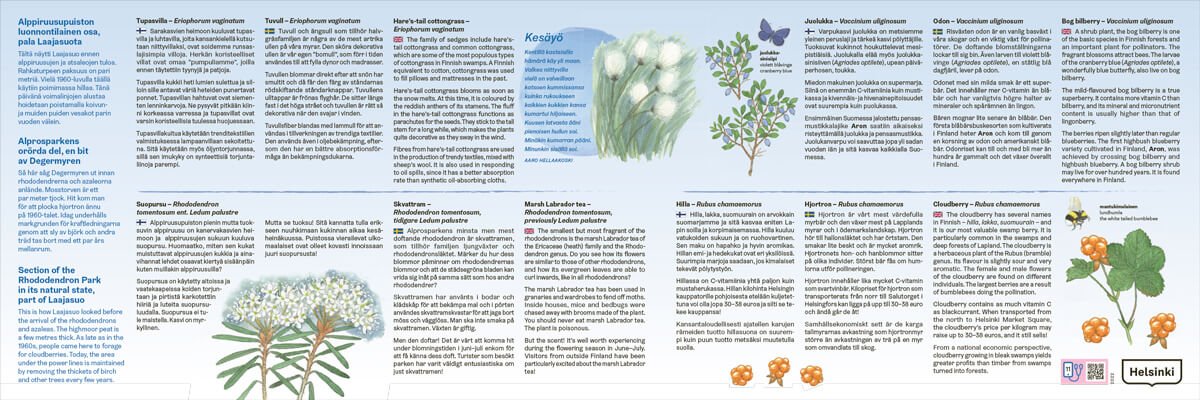
This is how Laajasuo looked before the arrival of the rhododendrons and azaleas. The highmoor peat is a few metres thick. As late as in the 1960s, people came here to forage for cloudberries. Today, the area under the power lines is maintained by removing the thickets of birch and other trees every few years.
Hare’s-tail cottongrass – Eriophorum vaginatum
The family of sedges include hare’s-tail cottongrass and common cottongrass, which are some of the most populous types of cottongrass in Finnish swamps. A Finnish equivalent to cotton, cottongrass was used to fill pillows and mattresses in the past.
Hare’s-tail cottongrass blooms as soon as the snow melts. At this time, it is coloured by the reddish anthers of its stamens. The fluff in the hare’s-tail cottongrass functions as parachutes for the seeds.They stick to the tall stem for a long while, which makes the plants quite decorative as they sway in the wind.
Fibres from hare’s-tail cottongrass are used in the production of trendy textiles, mixed with sheep’s wool. It is also used in responding to oil spills, since it has a better absorption rate than synthetic oil-absorbing cloths.
Marsh Labrador tea – Rhododendron tomentosum, previously Ledum palustre
The smallest but most fragrant of the rhododendrons is the marsh Labrador tea of the Ericaceae (heath) family and the Rhododendron genus. Do you see how its flowers are similar to those of other rhododendrons, and how its evergreen leaves are able to curl inwards, like in all rhododendrons?
The marsh Labrador tea has been used in granaries and wardrobes to fend off moths. Inside houses, mice and bedbugs were chased away with brooms made of the plant. You should never eat marsh Labrador tea. The plant is poisonous.
But the scent! It’s well worth experiencing during the flowering season in June–July. Visitors from outside Finland have been particularly excited about the marsh Labrador tea!
Bog bilberry – Vaccinium uliginosum
A shrub plant, the bog bilberry is one of the basic species in Finnish forests and an important plant for pollinators. The fragrant blossoms attract bees. The larvae of the cranberry blue (Agriades optilete ), a wonderfully blue butterfly, also live on bog bilberry.
The mild-flavoured bog bilberry is a true superberry. It contains more vitamin C than bilberry, and its mineral and micronutrient content is usually higher than that of lingonberry.
The berries ripen slightly later than regular blueberries. The first highbush blueberry variety cultivated in Finland, Aron, was achieved by crossing bog bilberry and highbush blueberry. A bog bilberry shrub may live for over hundred years. It is found everywhere in Finland.
Cloudberry – Rubus chamaemorus
The cloudberry has several names in Finnish – hilla, lakka, suomuurain – and it is our most valuable swamp berry. It is particularly common in the swamps and deep forests of Lapland. The cloudberry is a herbaceous plant of the Rubus (bramble) genus. Its flavour is slightly sour and very aromatic. The female and male flowers of the cloudberry are found on different individuals. The largest berries are a result of bumblebees doing the pollination.
Cloudberry contains as much vitamin C as blackcurrant. When transported from the north to Helsinki Market Square, the cloudberry’s price per kilogram may raise up to 30–38 euros, and it still sells! From a national economic perspective, cloudberry growing in bleak swamps yields greater profits than timber from swamps turned into forests.
-
12 Over 200 years of azalea breeding
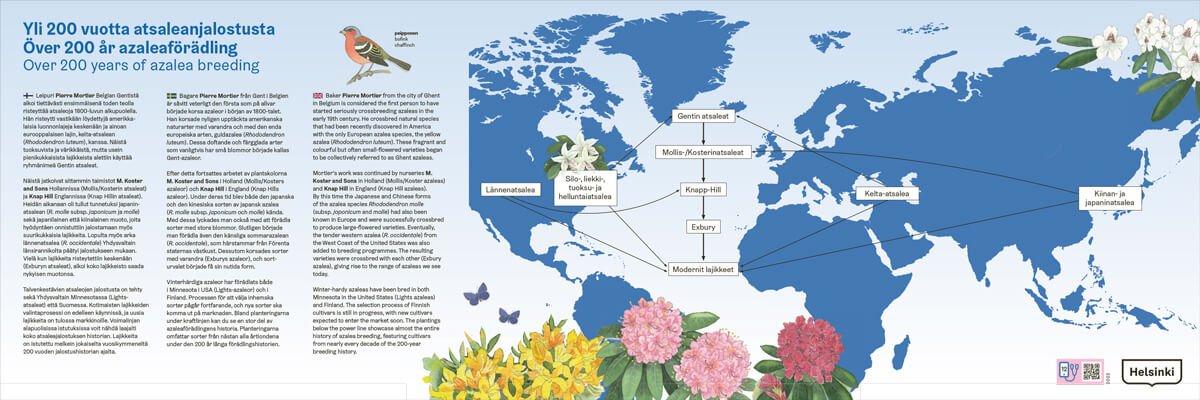
Baker Pierre Mortier from the city of Ghent in Belgium is considered the first person to have started seriously crossbreeding azaleas in the early 19th century. He crossbred natural species that had been recently discovered in America with the only European azalea species, the yellow azalea (Rhododendron luteum). These fragrant and colourful but often small-flowered varieties began to be collectively referred to as Ghent azaleas.
Mortier’s work was continued by nurseries M. Koster and Sons in Holland (Mollis/Koster azaleas) and Knap Hill in England (Knap Hill azaleas). By this time the Japanese and Chinese forms of the azalea species Rhododendron molle (subsp. japonicum and molle) had also been known in Europe and were successfully crossbred to produce large-flowered varieties. Eventually, the tender western azalea (R. occidentale) from the West Coast of the United States was also added to breeding programmes. The resulting varieties were crossbred with each other (Exbury azalea), giving rise to the range of azaleas we see today.
Winter-hardy azaleas have been bred in both Minnesota in the United States (Lights azaleas) and Finland. The selection process of Finnish cultivars is still in progress, with new cultivars expected to enter the market soon. The plantings below the power line showcase almost the entire history of azalea breeding, featuring cultivars from nearly every decade of the 200-year breeding history.
You can learn more about rhododendrons in Finland on the website of the Finnish Rhododendron Society.

